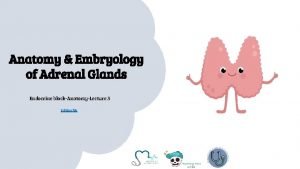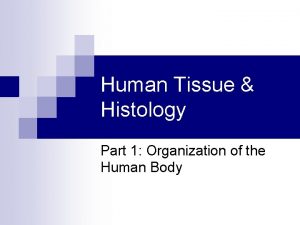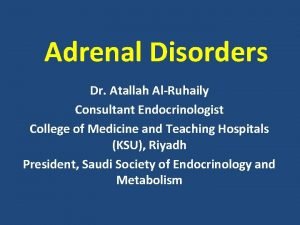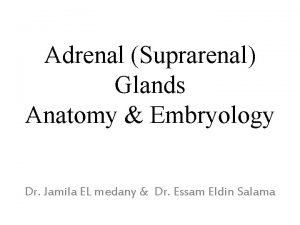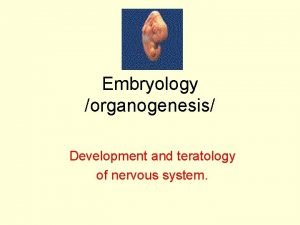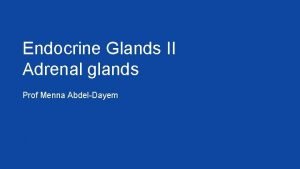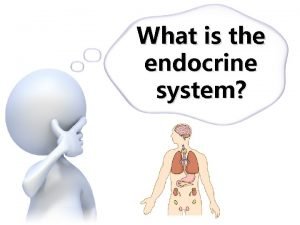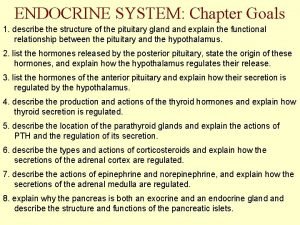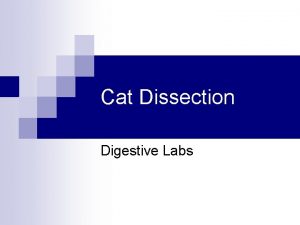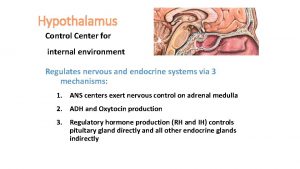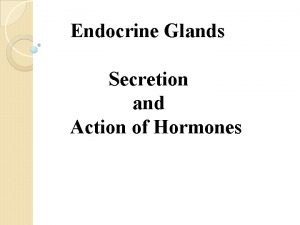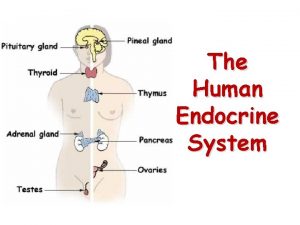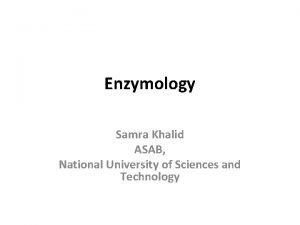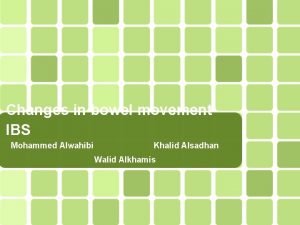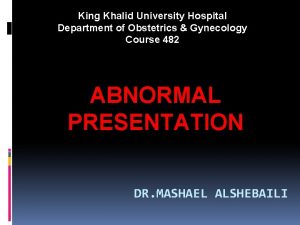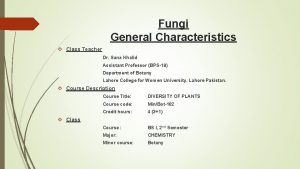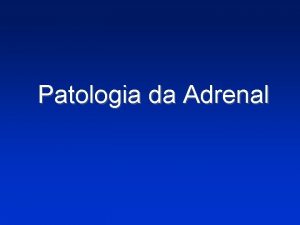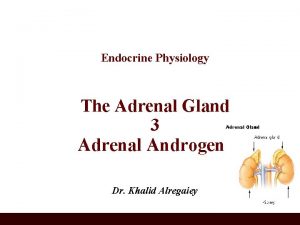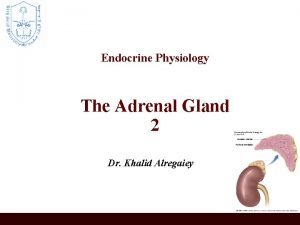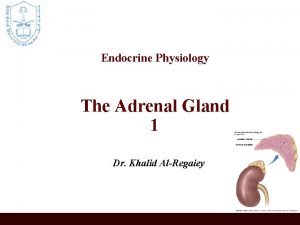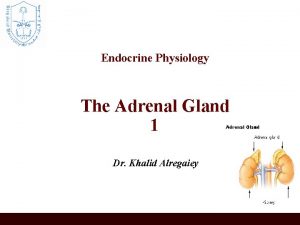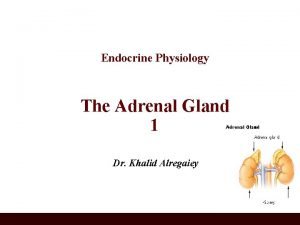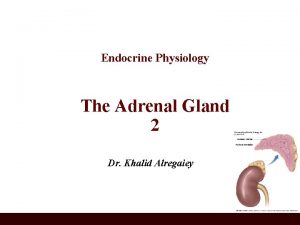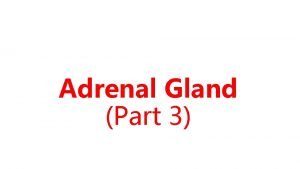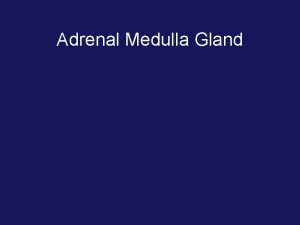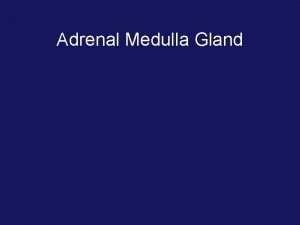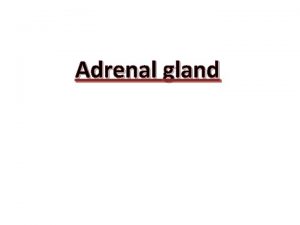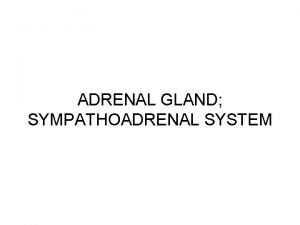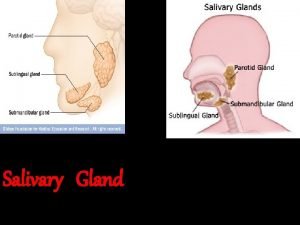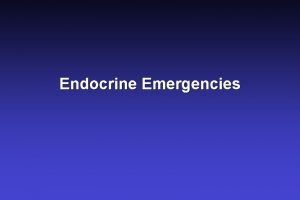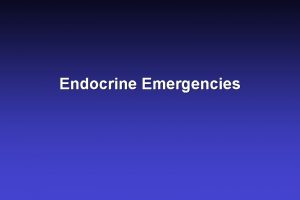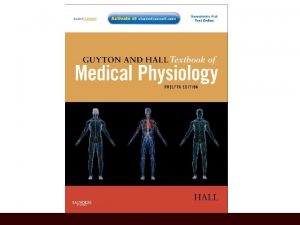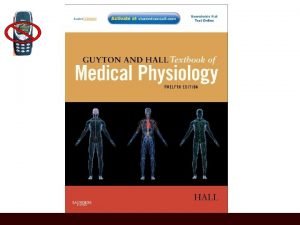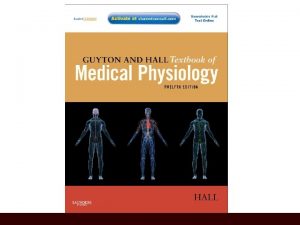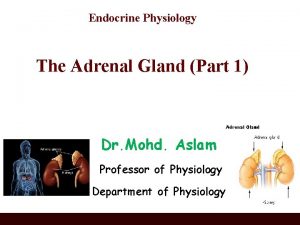Endocrine Physiology The Adrenal Gland 1 Dr Khalid





























- Slides: 29

Endocrine Physiology The Adrenal Gland 1 Dr. Khalid Alr. Regaiey

Adrenal (Suprarenal) Glands • Adrenal glands – paired, pyramid-shaped organs atop the kidneys • Weigh 6 -10 g. • Structurally and functionally, they are two glands in one • Adrenal cortex (80 -90%)– glandular tissue derived from embryonic mesoderm • Adrenal medulla (10 -20%)– formed from neural ectoderm, can be considered a modified sympathetic ganglion

Adrenal Cortex • Synthesizes and releases steroid hormones (corticosteroids) • Different corticosteroids are produced in each of the three layers: • Zona glomerulosa – mineralocorticoids (mainly aldosterone) • Zona fasciculata – glucocorticoids +Androgens (mainly cortisol and corticosterone) • Zona reticularis – gonadocorticoids + glucocorticoids (mainly dehydroepiandrosterone DHEA)

Adrenal Cortex

HPA Axis

Steroid Hormones: Structure

Steroid Hormones Synthesis • Steroids are derivatives of cholesterol • Cholesterol is from the lipid droplets in cortical cells (cholesterol esters in LDL) • Removed cholesterol is replenished by cholesterol in LDL in blood or synthesized from acetate

Steroid Hormones Synthesis (Cont. ) • Steroid hormones are synthesized and secreted on demand (not stored) • The first and rate-limiting step in the synthesis of all steroid hormones is conversion of cholesterol to pregnenolone by the enzyme cholesterol dismolase (aka cholesterol side chain cleavage (SCC) enzyme • Newly synthesized steroid hormones are rapidly secreted from the cell • Following secretion, all steroids bind to some extent to plasma proteins: CBG and albumin

Steroidogenesis

Genetic Defects in Adrenal Steroidogenesis • Congenital adrenal hyperplasia cortisol ACTH Adrenal hyperplasia • 21 -hydroxylase (P 450 c 21) deficiency: cortisol, corticosterone, and aldosterone deficiency *ACTH Adrenal hypertrophy and high amounts of androgen * Virilization of female (masculanization)

Congenital Adrenal Hyperplasia: 21β- Hydroxylase Deficiency 17 a-Hydroxylase (P 450 c 17) 17, 20 Lyase (P 450 c 17) CH 3 Cholesterol ACTH CH 3 O C OH Cholesterol desmolase (P 450 scc) Pregnenolone HO 3 b-Hydroxysteroid dehydrogenase 17 -Hydroxypregnenolone HO CH 3 C HO Dehydroepiandrosterone CH 3 O C O O OH Progesterone O 17 -Hydroxyprogesterone O CH 2 OH 21 b-Hydroxylase (P 450 c 21) C O Androstenedione CH 2 OH O C O OH 11 -Deoxycorticosterone O 11 b-Hydroxylase (P 450 c 11) CH 2 OH C O C HO Corticosterone Testosterone CH 2 OH HO O 11 -Deoxycortisol O OH Cortisol Estradiol

Congenital Adrenal Hyperplasia: 11β- Hydroxylase Deficiency 17 a-Hydroxylase (P 450 c 17) 17, 20 Lyase (P 450 c 17) CH 3 Cholesterol ACTH C CH 3 O O O C OH Cholesterol desmolase (P 450 scc) Pregnenolone HO 3 b-Hydroxysteroid dehydrogenase 17 -Hydroxypregnenolone HO CH 3 C HO Dehydroepiandrosterone CH 3 O C O O OH Progesterone O 17 -Hydroxyprogesterone O CH 2 OH 21 b-Hydroxylase (P 450 c 21) C CH 2 OH O C O Androstenedione O OH 11 -Deoxycorticosterone O 11 b-Hydroxylase (P 450 c 11) CH 2 OH C O C HO Corticosterone Testosterone CH 2 OH HO O 11 -Deoxycortisol O OH Cortisol Estradiol

Steroid Hormones: Action

Mineralocorticoids • Synthesized in zona glomerulosa • Regulate the electrolyte concentrations of extracellular fluids • Aldosterone – most important mineralocorticoid • Maintains Na+ balance by reducing excretion of sodium from the body

Mineralocorticoids: Aldosterone • A steroid hormone. • Essential for life. • Responsible for regulating Na+ reabsorption in the distal tubule and the cortical collecting duct • Target cells are called “principal (P) cell”. • It also affects Na+ reabsorption by sweat, salivary and intestinal cells. * Stimulates synthesis of more Na/K-ATPase pumps.

Aldosterone contin. - Aldosterone exerts the 90% of the mineralocorticoid activity. - Cortisol also have mineralocorticoid activity, but only 1/400 th that of aldosterone. - Secreted by Zona glomerulosa.

Corticosteroids & Their Relative Glucocorticoid & Mineralocorticoid Activities Compared to Cortisol Steroids Average Plasma Concentration (free and bound, μg/100 ml) Adrenal Steroids Cortisol Corticosterone Aldosterone Deoxycorticosterone Dehydropiandrosterone Synthetic Steroids Cortisone Prednisolone Methylprednisone Dexamethasone 9α-fluorocortisol Average Amount Secreted (mg/24 hr) Glucocorticoid Activity Mineralocorticoid Activity 12 0. 4 0. 006 175 15 3 0. 15 0. 2 20 1 0. 3 0. 2 __ 1 15. 0 3000 100 __ __ __ 0. 7 4 5 30 10 1. 0 0. 8 __ __ 125 Table 77 -1, Guyton & Hall


Aldosterone Actions • Maintains extracellular fluid volume by conserving body sodium. Aldosterone stimulates sodium & potassium transport in sweat glands, salivary glands, & intestinal epithelial cells.

Actions of Aldosterone Stimulates sodium reabsorption by distal tubule and collecting duct of the nephron and promotes potassium and hydrogen ion excretion • Increases transcription of Na/K pump • Increases the expression of apical Na channels and an Na/K/Cl cotransporter • By osmosis, water is also retained which expands ECF volume

Aldosterone Actions • Aldosterone stimulates the active secretion of potassium from the tubular cell into the urine. • Most potassium that is excreted daily results from distal tubular secretion. • Hence aldosterone is critical for disposal of daily dietary potassium load at normal plasma potassium concentrations. • Stimulates secretion of H+ by the kidney.


Regulation of Aldosterone Release 1. Increased potassium ion concentration in the extracellular fluid greatly increases aldosterone secretion. 2. Increased activity of the renin-angiotensin system (increased levels of angiotensin II) also greatly increases aldosterone secretion. 3. Increased sodium ion concentration in the extracellular fluid very slightly decreases aldosterone secretion. 4. ACTH from the anterior pituitary gland is necessary for aldosterone secretion but has little effect in controlling the rate of secretion.

Regulation of Aldosterone Release

Renin-angiotensin-aldosterone system Principal factor controlling Ang II levels is renin release. Decreased circulating volume stimulates renin release via: - Decreased BP (symp effects on JGA). - Decreased [Na. Cl] at macula densa (“Na. Cl sensor”) - - Decreased renal perfusion pressure (“renal” baroreceptor)

Hypoalsosteronism • Lack of aldosterone: • Increased sodium, chloride, water loss • Decrease ECF volume • Hyperkalemia • Mild acidosis • Plasma sodium decreases and may lead to circulatory collapse. Decrease cardiac output – shock - death within 4 days to a 2 weeks if not treated. • Cardiac toxicity

Hyperaldosteronism can be caused by: • Primary overproduction of aldosterone in conditions such as Conn’s syndrome. • Conditions of low cardiac output are also known to stimulate synthesis of aldosterone. • Both conditions result in sustained hypertension.

Clinical features of Hyperaldosteronism • Hypertension. • Hypokalemia • Nocturnal polyuria & polydipsia • Increased tubular (intercalated cells) hydrogen ion secretion, with resultant mild alkalosis. • Neuromuscular manifestations • weakness, paresthesia • intermittent paralysis

Overproduction of aldosterone • treatment • surgical for adenoma • medical with Spironolactone
 Betoderm
Betoderm Craniosacral region
Craniosacral region Adrenal gland epithelium
Adrenal gland epithelium Acth
Acth Acth stimulation test
Acth stimulation test Relation of adrenal gland
Relation of adrenal gland Coelomic epithelium
Coelomic epithelium Adrenal gland regions
Adrenal gland regions Adrenal gland hormones
Adrenal gland hormones Hypoglycemic shock
Hypoglycemic shock Cat dissection labeled
Cat dissection labeled Corticoliberin
Corticoliberin Cow adrenal gland
Cow adrenal gland Secretory gland
Secretory gland Estrogen effect
Estrogen effect Pineal gland pituitary gland
Pineal gland pituitary gland Pituitary gland and pineal gland spiritual
Pituitary gland and pineal gland spiritual Hypothyroidism dwarfism
Hypothyroidism dwarfism Khalid hossain books
Khalid hossain books Jurnal jamal
Jurnal jamal Khalid farhan course google drive
Khalid farhan course google drive Nauman khalid md
Nauman khalid md Dr sarah cox
Dr sarah cox Samra khalid
Samra khalid 911 in roman
911 in roman Khalid alsadhan
Khalid alsadhan Khalid al dossary
Khalid al dossary Hydrocephalas
Hydrocephalas Fariza khalid
Fariza khalid Dr sana khalid
Dr sana khalid
